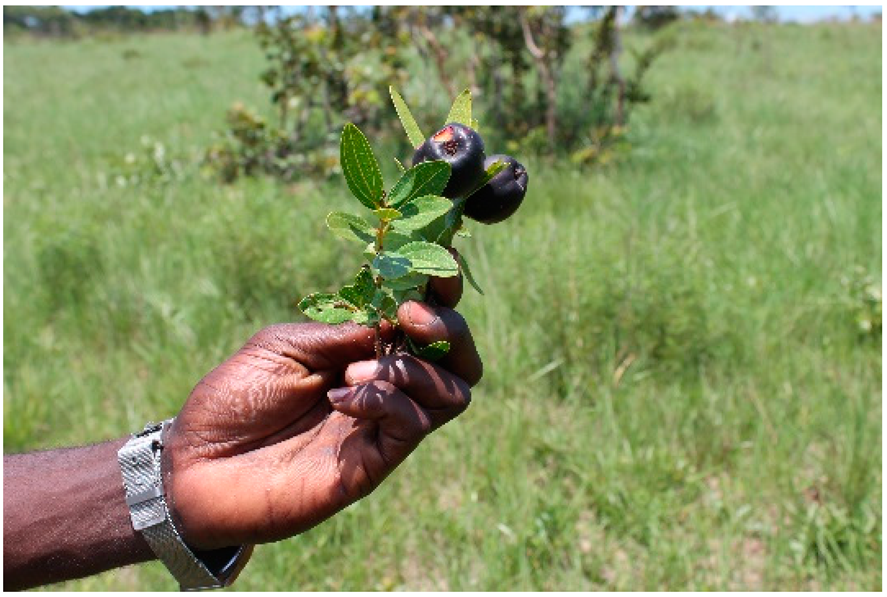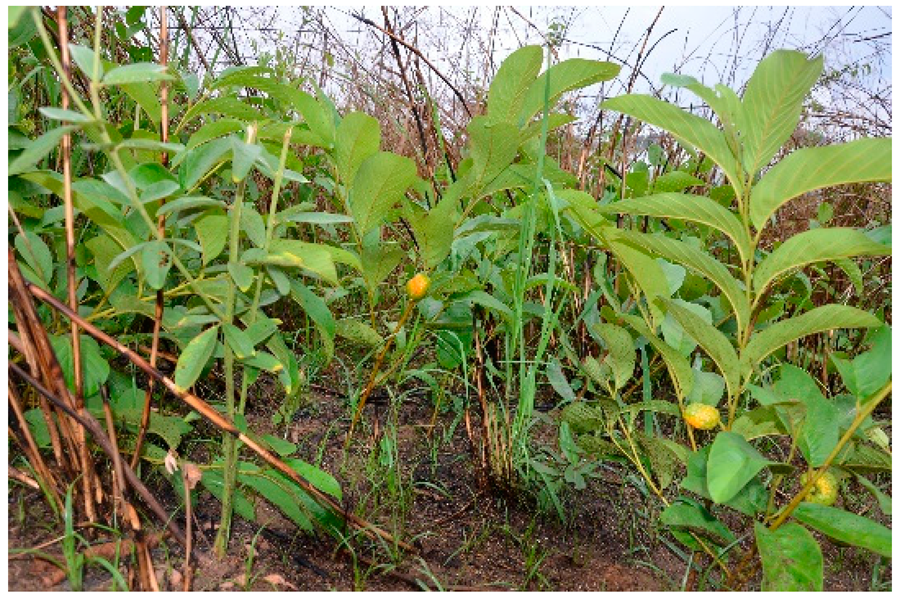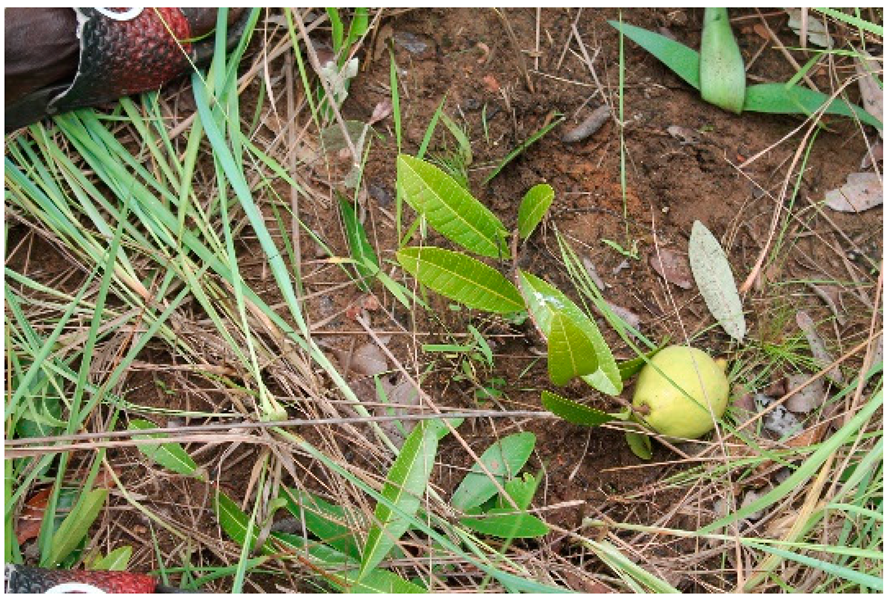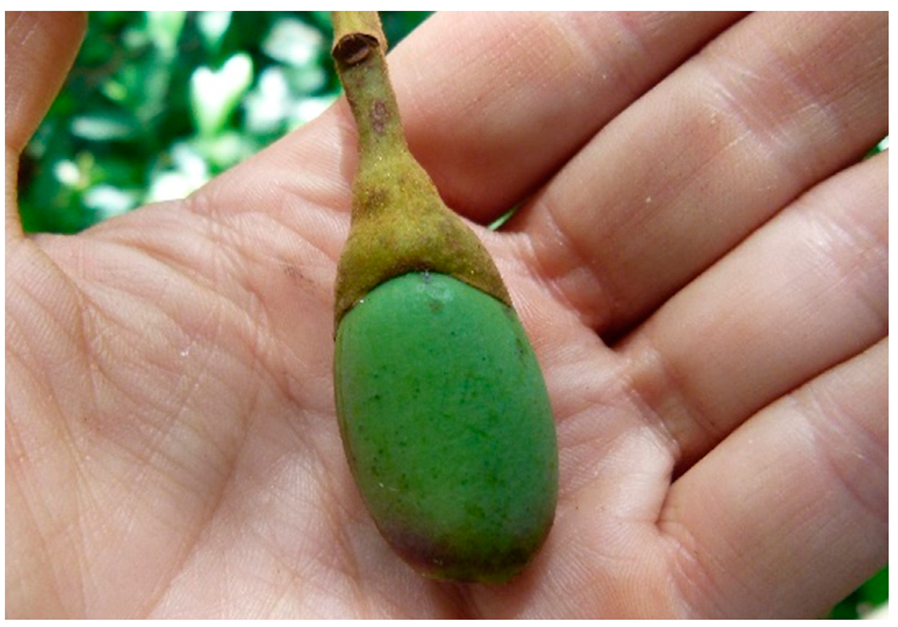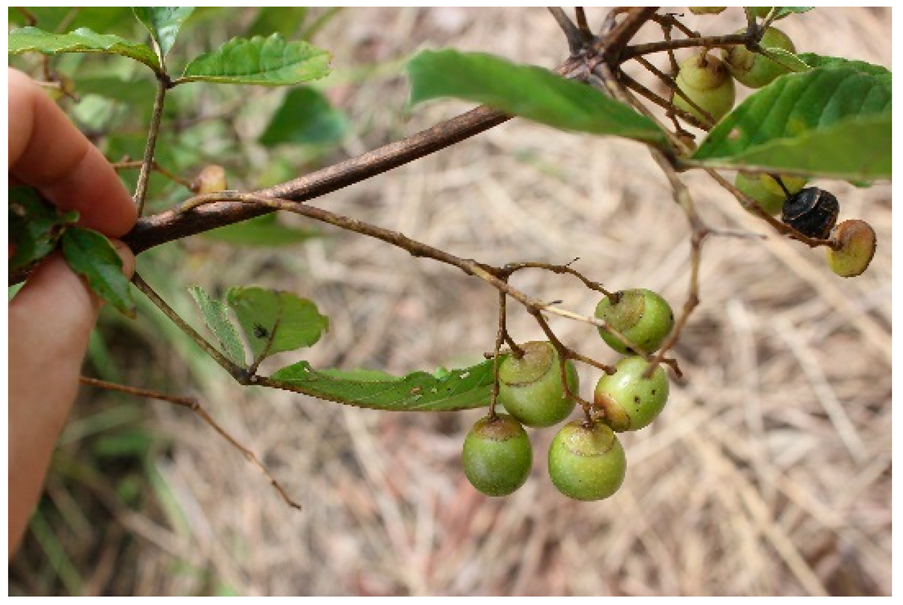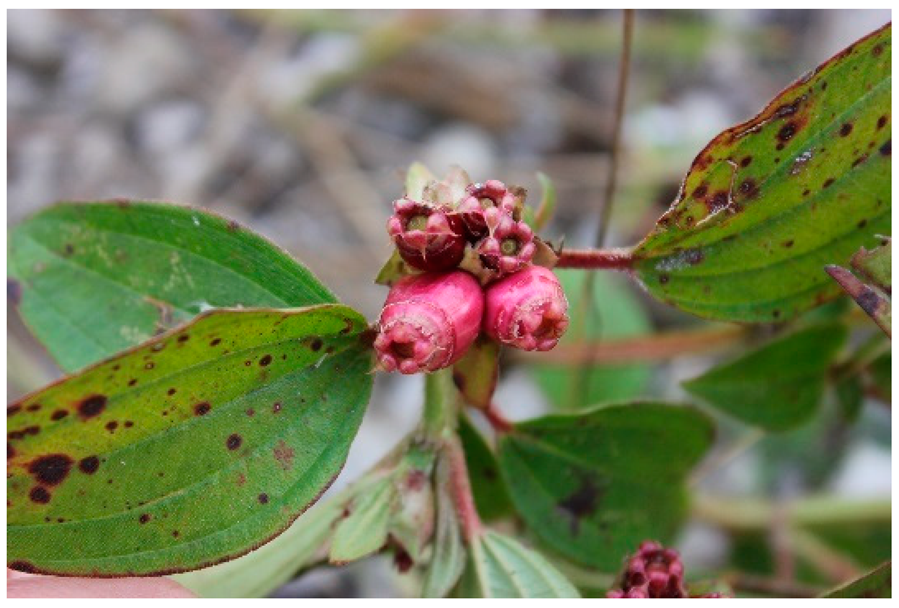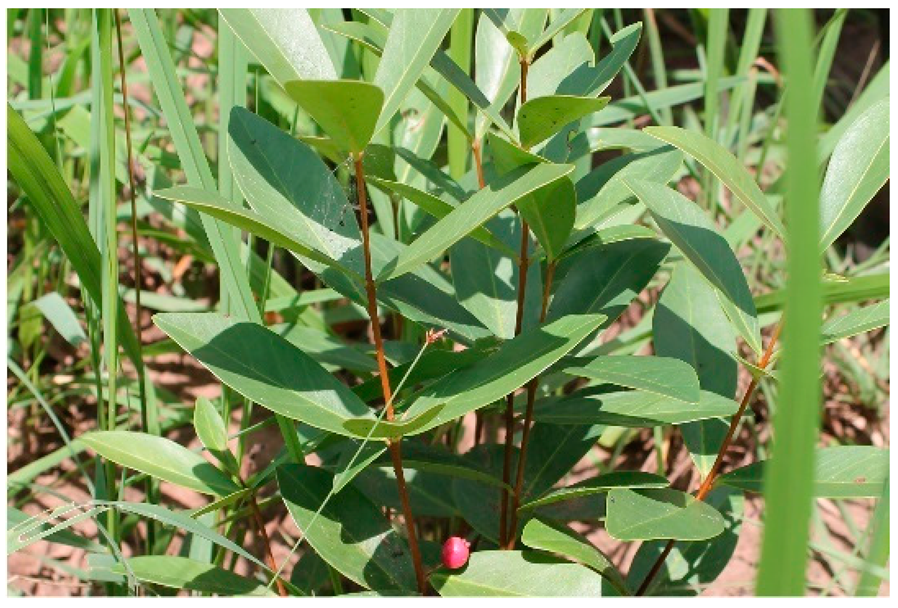Abstract
High metal contents of acidic soils from sub-Saharan Africa often prevent the cultivation of crops and lead to a low livestock yield. The carbohydrate rich diet of the Angolan population is low in minerals and vitamins, resulting in various deficiency syndromes and a high child mortality rate. Eight traditionally utilized plants (Anisophyllea quangensis, Annona stenophylla subsp. cuneata, Canarium schweinfurthii, Eugenia malangensis, Landolphia lanceolata, Raphionacme madiensis, Tristemma mauritianum, Vitex madiensis subsp. madiensis) with nutritional value for the Angolan population were analyzed for their soil and growing conditions. The species are adapted to the local conditions and can serve as crops for the unfavorable soils of the province Uíge. Chemical and physical characteristics of the uppermost soil (0–5 cm) and in 30 cm depth were analyzed. The plant-available macro-and micronutrients were determined using Mehlich 3 extraction. Data are completed with leaf tissue analyses, examining the uptake of minerals. As aluminum (Al) and manganese (Mn) are plant-available in high amounts, local plants evolved mechanisms dealing with those metals. These Al accumulators with foliar contents above 1000 mg/kg are Anisophyllea quangensis (7884 mg/kg), Landolphia lanceolata (6809 mg/kg), Tristemma mauritianum (4674 mg/kg), and Eugenia malangensis (13,989 mg/kg). All four species bear edible fruits with nutritional potential. The domestication and commercialization of those plants seem to be promising, utilizing local soils without expensive amelioration techniques.
1. Introduction
In sub-Saharan Africa, where the studied province Uíge is located in the North of Angola, unfavorable soils for agriculture are predominant. Low pH-values and the resulting deficiency in phosphorus (P), calcium (Ca), magnesium (Mg), as well as high levels of potentially toxic soluble aluminum (Al) and manganese (Mn) lead to the lowest agriculture and livestock yield worldwide [1,2,3]. The soil status of sub-Saharan countries even impairs due to the insufficient replacement of nutrients in agricultural systems, the absence of fertilizers, and mono-cropping [1]. In the province of Uíge (North Angola) maize, cassava, potatoes, beans, and peanuts are dominating crops [4]. Cultivation areas for these plant species are mainly obtained through the destructive technique of slash-and-burn farming. The temperature of those human placed fires affects the different properties of soil, such as nutrients, physical characteristics, bacteria, fungi, (in)vertebrates, as well as the composition of plant communities and biodiversity, in general [5]. Although the obtained ash has fertilizing effects, the nutrients are subject to rapid losses due to the enhanced wind and water erosion, soil leaching, transfer effects, and the harvest of crops [5]. Nevertheless, farming techniques of the rural Angolan population are restricted as the majority of soil amendments are expensive processes with power requirements, transportation, and application costs [6,7]. Particularly acidic soils, as the studied ones, need complex treatments for amelioration. Liming, as one of those techniques has only limited and short time effects on the topsoil acidity and adherent aluminum solubility [7]. In contrast to complex restructuring (natural) soil processes, an alternative approach is the cultivation of well-adapted naturally occurring species. This long-term and low-cost method can easily be adopted by locals. Metal-tolerant or accumulating species growing on these unfavorable soils can further supply useful or nutritional products. As malnutrition is still a serious problem for the Angolan population, suffering under a high Vitamin A deficiency and child mortality rate, this study focuses on local nutritional plants [8]. The unbalanced diet, mainly consisting of carbohydrate rich plants, has to be diversified using the potential of its rich local biodiversity. Given this background, our study analyzes the soil and metal accumulation properties of eight natural growing plant species with nutritional value for the Angolan population [9]. Different growth forms are included as trees (Canarium schweinfurthii), herbs growing along riverine (Tristemma mauritianum) or perennials which are adapted to savanna fires and mainly grow underground (Landolphia lanceolata). None of the examined species are cultivated or traded on a large scale, although the studied species bear edible plant parts which are appreciated by the rural population. The plant species are neglected in nutritional, ecological, and economic studies and are only mentioned in some ethnobotanical surveys [9,10,11,12]. The origin of all studied plant species is tropical Africa and, except Tristemma mauritianum, the species are not introduced in other continents yet. Accumulating species, for instance, Al accumulating plants can further serve as future crops for the utilization of the occurring acidic soils, supplying natural food products which can enhance the nutritional situation on-site.
2. Materials and Methods
2.1. Study Area and Data Collection
All of the plant and soil materials were collected in October/November 2018 and February/March 2019 in six municipalities of the province Uíge (Ambuila, Cangola, Kimbele, Milunga, Negage, Uíge) (Figure 1, Table 1). The province is located in a mountainous area up to 1200 m asl, with tilted, middle to late tertiary plantation levels, covered by Kalahari sand sheet [13]. Forest Savanna Mosaics of Zambezi savanna and coffee plantations characterize this region [14]. The rainy season lasts for a minimum of six months, classifying it as a tropical wet or dry savanna climate (Köppen-Geiger: Aw) [15,16].
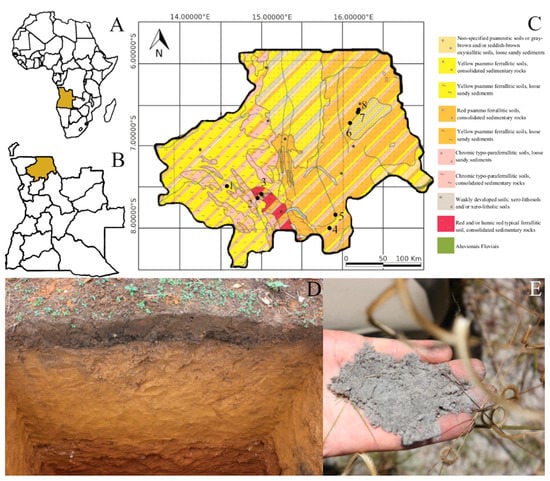
Figure 1.
Overview of sampling points and studied soils. (A): Location of Angola in Africa; (B): Location of the province Uíge in the north of Angola; (C): Adapted soil map for Uíge with specific sampling points of collected material [17]. 1: Vitex madiensis subsp. madiensis; 2: Tristemma mauritianum J.F. Gmel.; 3: Canarium schweinfurthii Engl.; 4: Annona stenophylla subsp. cuneata N. Robson; 5: Eugenia malangensis (O. Hoffm.) Nied.; 6: Raphionacme madiensis S. Moore; 7: Landolphia lanceolata (K. Schum.) Pichon; 8: Anisophyllea quangensis Engl. Ex Henriq.; (D): Soil profile (loamy texture) near Uíge; (E): Sandy soil of the north-eastern part of Uíge.

Table 1.
Overview of collected and analyzed plants and their family; scientific and vernacular name; voucher number according to Herbarium Dresdense; plant part of nutritional value; coordinates of soil and plant sampling sites with altitude [m above sea level]; growth form and photograph.
The majority of analyzed plant species grow on fine sand (Anisophyllea quangensis Engl. Ex Henriq., Landolphia lanceolata (K. Schum.) Pichon, Raphionacme madiensis S. Moore, Vitex madiensis subsp. madiensis), three species on sandy clay loam (Annona stenophylla subsp. cuneata N. Robson, Eugenia malangensis (O. Hoffm.) Nied., Tristemma mauritianum J.F. Gmel.) and one specimen on silty clay (Canarium schweinfurthii Engl.) (Figure 1, Table 2).

Table 2.
Physical properties of the collected soils related to the studied plant species; n.d.: Not determined.
The altitude of data sampling points varies from the lowest point for Vitex madiensis subsp. madiensis at an altitude of 434 m asl to the highest for Annona stenophylla subsp. cuneata (1152 m asl) (Table 1). Except Raphionacme madiensis, of which the edible root tuber is harvested, all analyzed plant species bear edible fruits appreciated by the local population [18]. The form and size of the respecitve edible plant part vary widely. Drupes of A. quangensis are plum-like, fleshy, and up to 3.5 cm, whereas the pink, fleshy fruit of T. mauritianum, including numerous small seeds, are in general only about 1.5 cm in length. Fruits of E. malangensis and Vitex madiensis subsp. madiensis have the same size as those of T. mauritianum, but are in contrast low concerning their water content. The black fruits of Vitex spp. have an intense taste and aroma, given the name “chocolate berries”. Fruits of this genus are traded regionally and the first cultivation trials started in Cameroon, but Vitex spp. is yet unknown outside Tropical Africa and comprehensive studies are lacking [19]. Fruits of the tree from C. schweinfurthii are similar to olives and several studies already analyzed essential oils, fatty acids or the pharmacological activity, lacking specific ecological data, which are needed for successful cultivation [20,21,22]. A. stenophylla subsp. cuneata and L. lanceolata mainly grow in clear savannas. As typical for the genus Landolphia, fruits of L. lanceolata contain a thick pericarp and a sweet, fleshy pulp (seeds are usually not consumed). The pear-shaped fruits are found on local markets when seasoning, but data regarding prices, trade, and profit margin lack as they have a partially small distribution area, only occuring in Angola and the Democratic Republic of Congo [23].
For each plant species, soil (topsoil and 30 cm depth) and leaf samples were collected for the different analyses on one spot (Figure 1).
Students and lecturers from the universities of Dresden and Uíge performed different field trips collecting plant and soil material in remote areas of the province. Working and collection permits were obtained from administrative heads, local authorities (‘Soba’), and the government (Instituto Nacional da Biodiversidade e Conservação (INBC), Angola). Leaf and soil samples in two depths (topsoil 0–5 cm, 25–30 cm) were taken for the analyses of each plant specimen. For the scientific identification herbarium vouchers were prepared and are available at the Herbarium Dresdense and the Virtual Herbaria JACQ (jacq.org; accessed on 10 January 2022).
2.2. Analytical Methods
2.2.1. Leaf Tissue Analyses
Fully expanded, most recently matured leaves without any visible damage (grub or disease) were collected for nutrient analyses. Dried, vacuum-sealed leaf samples were transported to Germany. A CNS elemental analyzer (Vario EL, Langenselbold, Germany) was used for the determination of C and N in shredded and pulverized dried leaves. A complete high-pressure digestion with HNO3 suprapur (Merck, Darmstadt, Germany) was performed in Teflon vessels. The clear digestion solutions obtained were filled with deionized H2O to a volume of 100 mL. Elements Al, Ca, Cu, Fe, K, Mg, Mn, Na, Zn, B, P, and S were simultaneously analyzed using an ICP-AES Spectrometer (CIROS, Spectro, Kleve, Germany).
2.2.2. Soil Analyses
Soil samples were taken in the uppermost soil (0–5 cm) and in 30 cm depth, except samples for the tree Canarium schweinfurthii and Tristemma mauritianum. At that site, only the topsoil could be sampled due to an inaccessible underground structure (big stones, extremely compacted). The dried soil samples were sieved (2 mm mesh). Soil pH was measured in 0.01 mol/l CaCl2 (ISO 10390:2005-12) with a glass electrode (Multilab 540, WTW GmbH, Weilheim, Germany). To determine the specific bulk density, exact soil volumes of 100 mL using a ring corer were dried for 24 h at 105 °C. Soil texture defined by the proportion of the different fractions of sand, silt, and clay was determined by sieving (particles ∅ > 63 µm) and sedimentation for smaller particles (Sedimat 4-12, UGT, Müncheberg, Germany). The total contents of C and N were determined for ground soil (Achat millstone) by a CNS elemental analyzer (Vario EL, Langenselbold, Germany). To analyze the plant-available macro-and micronutrients in the soil, the Mehlich 3 extraction [24] was applied for P, K, Ca, Mg, Na, B, S, Cu, Fe, Mn, and Zn. This method is recommended for acid (carbonate free) soils. The Mehlich 3 soil extraction solutions were analyzed by the ICP-AES Spectrometer (CIROS, Spectro, Kleve, Germany). For the element contents of soil and leaf tissue, the average is quoted with the specific standard deviation.
3. Results
3.1. Soil Properties
All of the studied plants grow on extremely acidic soils with a pH value below 4.6, except for the Canarium schweinfurthii site that was moderately acidic with a pH of 5.9 (CaCl2) (Table 3) [6]. In addition, the soil at this site had a low bulk density (0.7 g/cm3) corresponding to a high content of organic matter. All of the other examined soils have bulk densities ranging between 1.2 and 1.5 g/cm3, following the commonly observed increase from topsoil to subsoil layers (Table 2). The collection sites of Anisophyllea quangensis, Landolphia lanceolata, Raphionacme madiensis, and Vitex madiensis subsp. madiensis revealed a soil texture of sand (>90%) with prevailing fine sand (Table 2). The composition of topsoil and subsoil at these sites is consistent. All of the plants grow in forest savanna mosaics, typical for the studied province Uíge. The proportions of silt and clay at sites with Annona stenophylla subsp. cuneata, Eugenia malangensis, and Tristemma mauritianum is higher (textural class: loam). Only Canarium schweinfurthii grows on silty clay. At this site, it also has to be noted that the soil is very shallow and is characterized by a high stone content (66.7 mass%). These properties and the comparatively high pH of the C. schweinfurthii site are an indication for basalt as basement rock. The second shallow plant location (site of T. mauritianum; stone mass 62.6%) has a low pH (4.1) referring to a base-poor, granite-type of bedrock.

Table 3.
Chemical properties of the collected soils related to the studied plant species; pH value (CaCl2); total contents and ratios of C and N; plant-available (Mehlich-3) contents of macro-and micronutrients; BDL: Below detection limit; standard deviation in brackets behind the mean element content in g/kg or mg/kg.
The C to N ratio of all studied soils indicates a convenient situation for plant cultivation. The results of the Mehlich-3 extraction demonstrate that all of the studied soils are in general low in Ca, Mn, and P (Table 3) [25,26]. Only the soil of the Canarium schweinfurthii site has a high content of plant available Ca 2.55 g/kg corresponding to a higher pH. The Fe contents of the soils range in a medium level between 26.6 and 177 mg/kg, and are highest for the C. schweinfurthii site [25]. Moreover, this soil is rich in K as the soil of the Tristemma mauritianum and Eugenia malangensis sites. Furthermore, the collection sites of C. schweinfurthii, E. malangensis, and T. mauritianum are rich in Mg and S, whereas all of the other studied soil samples are low or very low in K, Mg, and S. The extractable plant-available Al contents are in general high and, thus, potentially toxic for most plants, mainly given the low soil pH values. This demonstrates that, especially the sandy soils (Anisophyllea quangensis, Landolphia lanceolata, Raphionacme madiensis, and Vitex madiensis subsp. madiensis) are low in nutrients and proportionally high in mobile Al and Fe.
3.2. Element Contents and Nutritional Status of Leaves
Levels for deficiencies, optimal supplies, and overdosages exist for various crops and elements (e.g., [3,27,28]). However, this information is lacking for the plant species that were analyzed in this study. Therefore, our results have been compared to general ranges and supply levels in other plants [27,28]. As only healthy plant individuals with no visible damages were analyzed, element contents falling below or exceeding the threshold of known ranges seem to have no negative effects on the plant and are only descriptive as a rough estimate.
Plant growth is limited most often by the elements N and P. Consequently, the N:P ratio of plant tissue can be used for the prediction of limitation [29]. A ratio above 16, considered as an indication for P limitation, is found for Anisophyllea quangensis, Canarium schweinfurthii, and Eugenia malangensis (Table 4) [29]. Raphionacme madiensis and Tristemma mauritianum are deficient in N (N:P < 14) (Table 4) [29]. Furthermore, as their N:S ratio is wide, they can be regarded as S deficient. Critical values for the N:S ratio vary from 9 to 17, depending on the specific plant species and developmental stage, indicating a potential lack of S in most of the analyzed plants in this study (Table 4) [30,31,32]. Only A. quangensis and E. malangensis show a narrow N:S ratio (1:1 and 2:1) and, thus, appear to be sufficiently supplied with S.

Table 4.
Element contents in leaves (dry mass) in g/kg or mg/kg; respective standard deviation in brackets behind the mean element content; contents in bold highlight particular high values.
All of the examined foliar contents are in the normal range for the macronutrients of Ca (3–30 g/kg), Mg (1–6 g/kg), and the majority also for K (5–20 g/kg) (Table 4) [27]. A. quangensis (2.92 g/kg), E. malangensis (2.03 g/kg), L. lanceolata (4.54 g/kg), and V. madiensis subsp. madiensis (3.19 g/kg) are low in K. The content of the beneficial, but non-essential element Na is low for all of the studied plants (<1000 mg/kg), also indicating a low soil salinity [27].
High foliar Fe contents were found for R. madiensis (1086 mg/kg), T. mauritianum (1307 mg/kg), and V. madiensis subsp. madiensis (1643 mg/kg) [27,28].
In general, plant species with (heavy) metal contents above 1000 mg/kg in the dried leaves are called metal accumulators. Four of the studied plant samples (A. quangensis 7884 mg/kg, E. malangensis 13,989 mg/kg, L. lanceolata 6809 mg/kg, T. mauritianum 4674 mg/kg) show Al contents above 1000 mg/kg, and thus have to be considered as Al-accumulators (Table 4). Furthermore, the Mn contents of leaves from those Al accumulators growing on extremely acidic soils are high. As the respective foliar contents exceed critical concentrations (>200 mg/kg), their Mn content is known to cause toxicity in non-tolerant crop plants [27,28]. An accumulation of other elements, such as B, Cu or Zn could not be identified (Table 4).
4. Discussion
As this study aims to identify nutritional plants for future cultivation trials utilizing the acidic soil conditions with partially high plant available metal contents, each plant species and the adherent characteristics are discussed separately, taking into account the respective edible plant part and the available literature resulting in a comprehensive description and guidance for upcoming cultivation.
As a result of the low pH and the competing effects of Al on Ca and Mg, the analyzed soils and plants are in general low in N, Ca, and Mg. Plants grown on those soils are usually adapted to high Al and Mn concentrations and a low Ca supply [3]. This is a tremendous advantage of the studied plant species towards the majority of crops, which have difficulties growing on these soils, often resulting in low yields. Furthermore, an efficient plant uptake of phosphorus is known for highly weathered tropical soil [33]. The P content of all studied soils is low, whereas the N:P ratio for the majority of studied plants reveals no strong N or P deficiency, indicating an efficient uptake of those minerals. The availability and uptake of K varies widely between the different soils and examined plant species, for instance, as for the soils of L. lanceolata (topsoil: 7.8 mg/kg) and E. malangensis (topsoil: 295 mg/kg). The studied soils are low in S, whereas the N:S ratio of leaves revealed that no plant is strongly S deficient. However, the foliar N:S ratio of T. mauritianum is the widest of this study (14). Global trading of the studied species is at the moment not known, whereas all of the plants have local importance and are, depending on the season and available quantities, traded on regional markets. The studied plants occur spontaneously as they originate from Tropical Africa. Therefore, preserving the existing populations seems to be a lucrative opportunity to utilize the inconvenient soil conditions, while cultivating fruits of nutritional relevance. Furthermore, an expansion of cultivation is conceivable for an introduction and marketing as new food crops.
4.1. Anisophyllea quangensis
The fruits of the geoxylic subshrub Anisophyllea quangensis are appreciated by the rural Angolan population for their sweet and tasty flavor. The woody axes of the species grow mainly underground on Kalahari sands as the studied soil sample from Uíge (textural class: fine sand) [34]. The high Al contents (7884 mg/kg) of the leaves substantiate earlier results since Anisophyllea is already known as an Al accumulator. To date, data for the rare species of A. quangensis were lacking [35]. Several studies focusing on the pharmacological effects of stem, bark, leaves or kernel oil were conducted, not taking element contents of the fruits into account [36,37]. Recently, fruits of A. quangensis were analyzed revealing raised contents of chromium (Cr) (0.4 mg/kg) and additional high contents of Al (713 mg/kg) [18]. The Agency for Toxic Substances and Disease Registry publishes a minimal risk level for oral exposure of Al with 1 mg/kg [38]. As A. quangensis only fruits twice a year, the consumption of those fruits seems to have no adverse health effects. However, the uptake of Cr has to be analyzed in detail studying the soil and leaf tissue of the species, of which Cr contents are lacking. A. quangensis is not cultivated, processed or dried, only once an informant indicated the preparation of an alcoholic beverage made of the ripe fruits. Cultivation and commercialization of this species seem to be promising and rewarding on acidic soils with high plant available Al (and Cr) contents.
4.2. Annona stenophylla subsp. cuneata
The shrub Annona stenophylla subsp. cuneata grows on sandy clay loam. The strong acidity of the soil results in elevated plant-available metal contents of the soil (i.e., Al, Fe). However, no indication of metal accumulation in leaves was found. Fruits and leaves are rich in Ca and K, which are beneficial for a balanced nutrition [18]. No nutritional nor cultivation studies are known, but processing techniques as juice production are conceivable.
4.3. Canarium schweinfurthii
As the root system of the tree Canarium schweinfurthii is extensive, the collected soil sample only presents a rough estimate of the growing properties. The textural class is determined as silty clay with a high proportion of silt (52%). High plant-available Ca contents were found in the soil, which however is not reflected in foliar concentrations. The plant does not accumulate metals, although the fruits are high in Zn (83.7 mg/kg) [18]. The fruits are eaten and sold commonly among people in the different tribes of Central Africa [39]. In Burkina Faso, the rural population notices a decline in the number of individuals, needing a successful cultivation as implemented in Cameroon [39,40]. Reforestation and cultivation have to be extended as fruits of C. schweinfurthii are rich in oil and suitable for processing as biscuits with nutritional quality [41,42].
4.4. Eugenia malangensis
The geoxylic subshrub Eugenia malangensis grows on acidic loam. The species belongs to Myrtaceae, a family already known to include several Al-accumulators (even in the genera Eugenia) [43]. However, data for the studied species E. malangensis are not available, stating for the first time that this species accumulates Al in aboveground tissues (leaf content >10,000 mg/kg) [44]. The edible fruits do not accumulate Al in those huge quantities (103 mg/kg) and the consumption seems to have no adverse health effects, especially taking into account the low weight of the edible portion [18,38]. Nevertheless, the fruits contain Cr (0.7 mg/kg) and titanium (Ti) (3.7 mg/kg), where adverse health effects are discussed controversially. Data regarding the soil and foliar contents of those metals are lacking and needed to evaluate the health risks and benefits of this species, as it can be a suitable crop for barren, acid sandy soils.
4.5. Landolphia lanceolata
The mainly subterraneous growing shrub Landolphia lanceolata bears delicious sweet fruits, which are easily collected and often sold on local markets [45]. The species grows on sandy soils with high soluble amounts of metals as Al. A few genera of the family Apocynaceae are known as Al accumulators, but no data are available for the whole genus Landolphia [35]. The high foliar Al content at our study site in North Angola (6809 mg/kg) is an indication for Al accumulation. The edible fruit pulp of L. lanceolata is high in Al (723 mg/kg) similar to other species (L. congolensis, L. dewevrei) from this genus, which is a further evidence for Al accumulation [18]. The consumption of these fruits has to be studied in detail, taking into account the amount per edible portion and the frequency of consumption, as a high regular Al uptake is known to affect the nervous system [38]. Mature fruits appear throughout the whole year, whereas this species seem to be a suitable crop for sandy soils in Angola.
4.6. Raphionacme madiensis
The analyzed individual of the species Raphionacme madiensis grows on fine sand. However, it is known that the habitats can vary considerably from silt over clay to loam [46]. The Fe content is high in leaves (1086 mg/kg), but low in the edible tuber [18]. The mineral content in general is low, but seem to vary depending on the habitat. Data regarding the nutritional benefits are not available and need future investigations, especially concerning the carbohydrate proportion.
4.7. Tristemma mauritianum
The Al content of leaves from Tristemma mauritianum (4674 mg/kg) suggests the accumulation of this metal. The genus Tristemma is already known to include several Al accumulating species [43]. The edible fruits contain 316 mg/kg of Al and pose no risk to human health [18,38]. The Fe content of leaves and fruits is elevated, playing an important role combating malnutrition in Angola. The studied soil at the site of T. mauritianum is rich in macronutrients (K, Mg, Ca) differing from the sandy habitats of the majority of other analyzed plants. T. mauritianum grows in shady, humid places near riverine. Therefore, the cultivation of this species needs trees that provide shade. Reforestation and/or protection of existing populations seem to be most promising as a start for commercialization.
4.8. Vitex madiensis subsp. madiensis
Edible fruits of Vitex madiensis subsp. madiensis are harvested, consumed, and commercialized on local and regional markets throughout Central and West Africa [47]. The so-called “chocolate berries” of the genus Vitex with more than 70 species are promising for agroforestry and rural reforestation [19]. They are high yielding, self-sustaining, and appreciated for the production of honey, as bees regularly visit the plants [19]. The analyzed species in our study in Angola grows on fine sand in savanna, making it a suitable crop for the cultivation and regeneration of disturbed open vegetation sites. The leaves are rich in Fe (1643 mg/kg), in contrast to the fruits [18]. Studies evaluating the relation between contents in the soil and plant uptake seem to be promising for the supply with Fe. The agroforestry sector should also take advantage of the easy vegetative propagation of Vitex madiensis subsp. madiensis via aerial layering or cutting [47]. The species is suitable for the greening of barren vegetation sites, bearing delicious fruits and an alternative income opportunity, as indicated by salesmen from Cameroon which generated up to USD 1800 in 7 months selling Vitex spp. [48].
5. Conclusions
Our study in North Angola identified three Al accumulators growing on extremely acidic sandy soils (A. quangensis, E. malangensis, and L. lanceolata). Moreover, leaves of T. mauritianum growing on sandy clay loam exhibit an Al-content exceeding 1000 mg/kg. As high soluble Al contents are the major difficulty for crop production in Sub-Saharan Africa, those species seem to be suitable crops for the unfavorable soils. Common among the identified Al accumulators are high foliar Mn contents, which reflect the increased mobility of both elements in the soil. The high C:N ratio is an indication for elevated contents of lignin and cellulose. The decomposition of plant parts from specimens with a high C:N ratio is slow. A co-cultivation of the low C:N ratio covers the crops from the family of Fabaceae. In addition, Brassicaceae seem to have positive effects on the C:N ratio in the soil. The identified Al accumulators have a restricted distribution area, only T. mauritianum inhabits regions outside of Central Africa. These rare species have to be considered particularly in future protection actions as they are adapted to the poor soil conditions (Al and Mn toxicity, acid pH) [35]. Furthermore, the systematic screening for metal accumulation properties of the genera of interest have to be conducted, especially for Landolphia spp. where fruits are already known to contain >1000 mg/kg Al in fresh fruit pulp [18]. Although Vitex madiensis subsp. madiensis shows no metal accumulation properties, the plant also grows on sandy soil and seems to be a suitable crop for barren, open vegetation sites, bearing tasty “chocolate berries”. At the moment, fruits of A. quangensis, C. schweinfurthii, L. lanceolata, and V. madiensis subsp. madiensis are found on local markets. Therefore, they are of special interest in the contribution of rural household income. Global trading analyses of the studied species were still not conducted. As a result, data regarding prices and profit margins are lacking. However, the sale of natural products is often even lucrative on a regional level, as high demand and convenient sales increase exist in the capital Luanda [49]. Cultivating the studied species of interest on barren, open vegetation sites can help in improving the nutritional situtation on-site, generating an alternative income, and utilizing the exisiting soil conditions without expensive ameliorating techniques.
Author Contributions
Conceptualization, investigation, data curation, writing—original draft, C.B.; project administration, writing—review and editing, T.L.; investigation, M.H.G.P.; investigation, F.A.; supervision, writing—review and editing, C.N.; methodology, supervision, writing—review and editing, K.-H.F. All authors have read and agreed to the published version of the manuscript.
Funding
Travel of first author Christin Baumgärtel was financially supported by the Erasmus+ program. Special thanks go to the Graduate Academy of the Technische Universität Dresden, which granted a scholarship for the expenses of the first author as a PhD student.
Institutional Review Board Statement
Not applicable.
Informed Consent Statement
Informed consent was obtained from all subjects involved in the study.
Acknowledgments
We would like to thank all of the participants and informants in Angola, who guided us to the points of interest and gave us the permission to work in the surrounding areas. The published results were obtained in collaboration with the Instituto Nacional de Biodiversidade e Conservação (INBC) of the Ministério da Cultura, Turismo e Ambiente da República de Angola. The authors are greatly indebted to Gisela Cisielski, Manuela Ungerand, and Thomas Klinger for supporting the analytical work in the laboratory of the Institute of Soil Science and Site Ecology, Department of Forest Sciences, Technische Universität Dresden, Germany. For assistance in the identification of Raphionacme madiensis we thank Magdil Pienaar.
Conflicts of Interest
The authors declare no conflict of interest.
References
- FAO; ITPS. Status of the World’s Soil Resources (SWSR)—Main Report; Food and Agriculture Organization of the United Nations and Intergovernmental Technical Panel on Soils: Rome, Italy, 2015; ISBN 978-92-5-109004-6. [Google Scholar]
- McCann, J.C. Maize and Grace: Africa’s Encounter with a New World Crop, 1500–2000, 1st ed.; Harvard University Press: Cambridge, MA, USA, 2005; ISBN 978-0-674-02557-8. [Google Scholar]
- Marschner, H. Mineral Nutrition of Higher Plants, 2nd ed.; Acadamic Press: London, UK, 1995. [Google Scholar]
- Da Rocha, M.J. Desigualidades e Assimetrias Regionais em Angola—Os Factores de Competitividade Terriorial; Universidade Católica de Angola Centro de Estudos e Investigação Científica: Luanda, Angola, 2010. [Google Scholar]
- Hauser, S.; Norgrove, L. Slash-and-Burn Agriculture, Effects of. In Encyclopedia of Biodiversity; Academic Press: Waltham, MA, USA, 2013; pp. 551–562. ISBN 978-0-12-384720-1. [Google Scholar]
- Motsara, M.R.; Roy, R.N. Guide to Laboratory Establishment for Plant Nutrient Analysis; FAO Fertilizer and Plant Nutrition Bulletin; Food and Agriculture Organization of the United Nations: Rome, Italy, 2008; ISBN 978-92-5-105981-4. [Google Scholar]
- Farina, M.P.W.; Channon, P.; Thibaud, G.R. A Comparison of Strategies for Ameliorating Subsoil Acidity I. Long-Term Growth Effects. Soil Sci. Soc. Am. J. 2000, 64, 646–651. [Google Scholar] [CrossRef]
- McDonald, C.; Hyder, Z.; Albino Cossa, H. Angola Nutrition Gap Analysis; The International Bank for Reconstruction and Development/The World Bank: Washington, DC, USA, 2011. [Google Scholar]
- Lautenschläger, T.; Monizi, M.; Pedro, M.; Mandombe, J.L.; Bránquima, M.F.; Heinze, C.; Neinhuis, C. First Large-Scale Ethnobotanical Survey in the Province of Uíge, Northern Angola. J. Ethnobiol. Ethnomed. 2018, 14, 51. [Google Scholar] [CrossRef] [PubMed] [Green Version]
- Rabearivony, A.D.; Kuhlman, A.R.; Razafiariso, Z.L.; Raharimalala, F.; Rakotoarivony, F.; Randrianarivony, T.; Rakotoarivelo, N.; Randrianasolo, A.; Bussmann, R.W. Ethnobotanical Study of the Medicinal Plants Known by Men in Ambalabe, Madagascar. Ethnobot. Res. Appl. 2015, 14, 123–138. [Google Scholar] [CrossRef] [Green Version]
- Youmsi, R.D.F.; Fokou, P.V.T.; Menkem, E.Z.; Bakarnga-Via, I.; Keumoe, R.; Nana, V.; Boyom, F.F. Ethnobotanical Survey of Medicinal Plants Used as Insects Repellents in Six Malaria Endemic Localities of Cameroon. J. Ethnobiol. Ethnomed. 2017, 13, 33. [Google Scholar] [CrossRef] [Green Version]
- Novotna, B.; Polesny, Z.; Pinto-Basto, M.F.; Van Damme, P.; Pudil, P.; Mazancova, J.; Duarte, M.C. Medicinal Plants Used by ‘Root Doctors’, Local Traditional Healers in Bié Province, Angola. J. Ethnopharmacol. 2020, 260, 112662. [Google Scholar] [CrossRef]
- Beernaert, F.R. Development of a Soil and Terrain Map/Database for Angola; Food and Agriculture Organization of the United Nations: De Pinte, Belgium, 1997. [Google Scholar]
- Barbosa, L.A.G. Carta Fitogeográfica de Angola; Instituto de Investigação Científica de Angola: Luanda, Angola, 1970. [Google Scholar]
- Briggs, D.J.; Smithson, P. Fundamentals of Physical Geography; Rowman & Littlefield: Lanham, MD, USA, 1986; ISBN 978-0-8476-7520-3. [Google Scholar]
- Peel, M.C.; Finlayson, B.L.; McMahon, T.A. Updated World Map of the Köppen-Geiger Climate Classification. Hydrol. Earth Syst. Sci. 2007, 11, 1633–1644. [Google Scholar] [CrossRef] [Green Version]
- Missão de Pedologia de Angola e Moçambique & Centro de Estudos de Pedologia Tropical Carta Generalizada Dos Solos de Angola (3a Aproximação); Ministério do Ultramar: Luanda, Angola, 1968.
- Baumgärtel, C.; Götzke, L.; Weigand, J.J.; Neinhuis, C.; Panzo, M.H.G.; Afonso, F.; Lautenschläger, T. Comprehensive Study of Beneficial and Hazardous Minerals of 43 Traditionally Consumed Fruits and Vegetables of the Province Uíge, Angola. Food Sci. Nutr. 2021. manuscript submitted. [Google Scholar]
- National Research Council. Lost Crops of Africa: Volume III: Fruits; The National Academies Press: Washington, DC, USA, 2008; p. 11879. ISBN 978-0-309-10596-5. [Google Scholar]
- Koudou, J.; Abena, A.A.; Ngaissona, P.; Bessiere, J.M. Chemical Composition and Pharmacological Activity of Essential Oil of Canarium schweinfurthii. Fitoterapia 2005, 76, 700–703. [Google Scholar] [CrossRef]
- Nkwor, A.N.; Ukoha, P.O.; Wise, W.R.; Nwaji, N.N.; Flowers, K. Fatty Acid Profile and Production of Fatliquor from Canarium schweinfurthii Mesocarp Oil. Pertanika J. Sci. Technol. 2019, 27, 2221–2243. [Google Scholar]
- Georges, A.N.; Olivier, C.K.; Simard, R.E. Canarium schweinfurthii Engl.: Chemical Composition of the Fruit Pulp. J. Am. Oil Chem. Soc. 1992, 69, 317–320. [Google Scholar] [CrossRef]
- Mawunu, M.; Makuntima, P.; Masidivinga, L.; Lautenschläger, T.; Luyindula, N.; Ngbolua, K.N.; Lukoki, L. First Survey on the Edible Non-Wood Forest Products Sold in Uíge Province, Northern Angola. Eur. J. Agric. Food Sci. 2020, 2, 1–9. [Google Scholar] [CrossRef]
- Mehlich, A. Mehlich 3 Soil Test Extractant: A Modification of Mehlich 2 Extractant. Commun. Soil Sci. Plant Anal. 1984, 15, 1409–1416. [Google Scholar] [CrossRef]
- Zbíral, J. Determination of Plant-Available Micronutrients by the Mehlich 3 Soil Extractant—A Proposal of Critical Values. Plant Soil Environ. 2016, 62, 527–531. [Google Scholar] [CrossRef] [Green Version]
- Espinoza, L.; Slaton, N.; Mozaffari, M. Understanding the Numbers on Your Soil Test Report; University of Arkansas Cooperative Extension Service Printing Services: Fayetteville, AR, USA, 2010. [Google Scholar]
- Reeves, R.D.; Baker, A.J.M. Metal-Accumulating Plants. In Phytoremediation of Toxic Metals: Using Plants to Clean Up the Environment; John Wiley: New York, NY, USA, 2000; pp. 193–229. ISBN 978-0-471-19254-1. [Google Scholar]
- White, P.J.; Brown, P.H. Plant Nutrition for Sustainable Development and Global Health. Ann. Bot. 2010, 105, 1073–1080. [Google Scholar] [CrossRef] [Green Version]
- Koerselman, W.; Meuleman, A.F.M. The Vegetation N:P Ratio: A New Tool to Detect the Nature of Nutrient Limitation. J. Appl. Ecol. 1996, 33, 1441. [Google Scholar] [CrossRef]
- Blake-Kalff, M.M.A.; Hawkesford, M.J.; Zhao, F.J.; McGrath, S.P. Diagnosing Sulfur Deficiency in Field-Grown Oilseed Rape (Brassica napus L.) and Wheat (Triticum aestivum L.). Plant Soil 2000, 225, 95–107. [Google Scholar] [CrossRef]
- Rasmussen, P.E.; Ramig, R.E.; Skin, L.G.; Rohde, C.R. Tissue Analyses Guidelines for Diagnosing Sulfur Deficiency in White Wheat. Plant Soil 1977, 46, 153–163. [Google Scholar] [CrossRef]
- Calvo, N.I.R.; Echeverría, H.E.; Rozas, H.S. Usefulness of Foliar Nitrogen-Sulfur Ratio in Spring Red Wheat. J. Plant Nutr. 2008, 31, 1612–1623. [Google Scholar] [CrossRef]
- Sánchez, P.A.; Salinas, J.G. Low-Input Technology for Managing Oxisols and Ultisols in Tropical America. In Advances in Agronomy; Academic Press: Washington DC USA, 1981; Volume 34, pp. 279–406. ISBN 978-0-12-000734-9. [Google Scholar]
- Torre, A.R.; Gonçalves, A.E. Rhizophoraceae. In Flora Zambesiaca; Kew Publishing and Flora Zambesiaca Managing Committee: London, UK, 1978; Volume 4. [Google Scholar]
- Jansen, S.; Broadley, M.R.; Robbrecht, E.; Smets, E. Aluminum Hyperaccumulation in Angiosperms: A Review of Its Phylogenetic Significance. Bot. Rev. 2002, 68, 235–269. [Google Scholar] [CrossRef]
- Bari, N.A.A.; Ferdosh, S.; Sarker, M.Z.I.; Yunus, K.; Shahari, R.; Hamzah, N.N. Phytochemical Composition, Biological Activities and Processing Method of Genus Anisophyllea: A Review. Nat. Prod. J. 2017, 7, 176–185. [Google Scholar] [CrossRef]
- Nkengurutse, J.; Mansouri, F.; Bekkouch, O.; Ben Moumen, A.; Masharabu, T.; Gahungu, G.; Serghini, H.C.; Khalid, A. Chemical Composition and Oral Toxicity Assessment of Anisophyllea boehmii Kernel Oil: Potential Source of New Edible Oil with High Tocopherol Content. Food Chem. 2019, 278, 795–804. [Google Scholar] [CrossRef]
- ATSDR. Toxicological Profile for Aluminium; Agency for Toxic Substances and Disease Registry, U.S. Department of Health and Human Services, Public Health Service: Atlanta, GA, USA, 2008; p. 357. [Google Scholar]
- Traoré, L.; Hien, M.; Ouédraogo, I. Usages, disponibilité et stratégies endogènes de préservation de Canarium schweinfurthii (Engl.) (Burseraceae) dans la région des Cascades (Burkina Faso)—Uses, availability and endogenous conservation strategies of Canarium schweinfurthii (Engl.) (Burseraceae) in the Cascades region (Burkina Faso). Ethnobot. Res. Appl. 2021, 21, 1–17. [Google Scholar] [CrossRef]
- Njoukam, R.; Peltier, R. L’aiélé (Canarium Schweinfurthii Engl.): Premier Essai de Plantation Dans l’ouest Du Cameroun. Fruits 2002, 57, 239–248. [Google Scholar] [CrossRef] [Green Version]
- Obeta, N.A.; Azike, G.C.; Asogwa, I.S. Nutritional Composition, Physical Characteristics, and Sensory Attributes of Wheat Based Biscuits Enriched with Bullet Pear (Canarium schweinfurthii) Fruit Pulp. J. Food Sci. Technol. 2020, 57, 832–839. [Google Scholar] [CrossRef]
- Malaisse, F.; Parent, G. Edible Wild Vegetable Products in the Zambezian Woodland Area: A Nutritional and Ecological Approach. Ecol. Food Nutr. 1985, 18, 43–82. [Google Scholar] [CrossRef]
- Jansen, S.; Watanabe, T.; Smets, E. Aluminium Accumulation in Leaves of 127 Species in Melastomataceae, with Comments on the Order Myrtales. Ann. Bot. 2002, 90, 53–64. [Google Scholar] [CrossRef] [Green Version]
- Masunaga, T.; Kubota, D.; Hotta, M.; Wakatsuki, T. Mineral Composition of Leaves and Bark in Aluminum Accumulators in a Tropical Rain Forest in Indonesia. Soil Sci. Plant Nutr. 1998, 44, 347–358. [Google Scholar] [CrossRef] [Green Version]
- Persoon, J.G.M. The African Species of Landolphia P.Beauv. Series of Revisions of Apocynaceae XXXIV; Wageningen Agricultural University Papers: Wageningen, The Netherlands, 1992; p. 234. [Google Scholar]
- Venter, H.J.T. A Taxonomic Revision of Raphionacme (Apocynaceae: Periplocoideae). S. Afr. J. Bot. 2009, 75, 292–350. [Google Scholar] [CrossRef]
- Mapongmetsem, P.M. Domestication of Vitex madiensis in the Adamawa Highlands of Cameroon: Phenology and Propagation. Akdeniz Üniversitesi Ziraat Fakültesi Derg. 2006, 19, 269–278. [Google Scholar]
- Mapongmetsem, P.; Kapchie, V.; Tefempa, B. Diversity of Local Fruit Trees and Their Contribution in Sustaining the Rural Livelihood in the Northern Cameroon. Ethiop. J. Environ. Stud. Manag. 2012, 5, 32–36. [Google Scholar] [CrossRef] [Green Version]
- Heinze, C.; Dundão, M.D.F.; Neinhuis, C.; Lautenschläger, T. Economic Potential of Selected Native Plants from Cuanza Norte, Northern Angola. Econ. Bot. 2019, 73, 96–111. [Google Scholar] [CrossRef]
Publisher’s Note: MDPI stays neutral with regard to jurisdictional claims in published maps and institutional affiliations. |
© 2022 by the authors. Licensee MDPI, Basel, Switzerland. This article is an open access article distributed under the terms and conditions of the Creative Commons Attribution (CC BY) license (https://creativecommons.org/licenses/by/4.0/).
